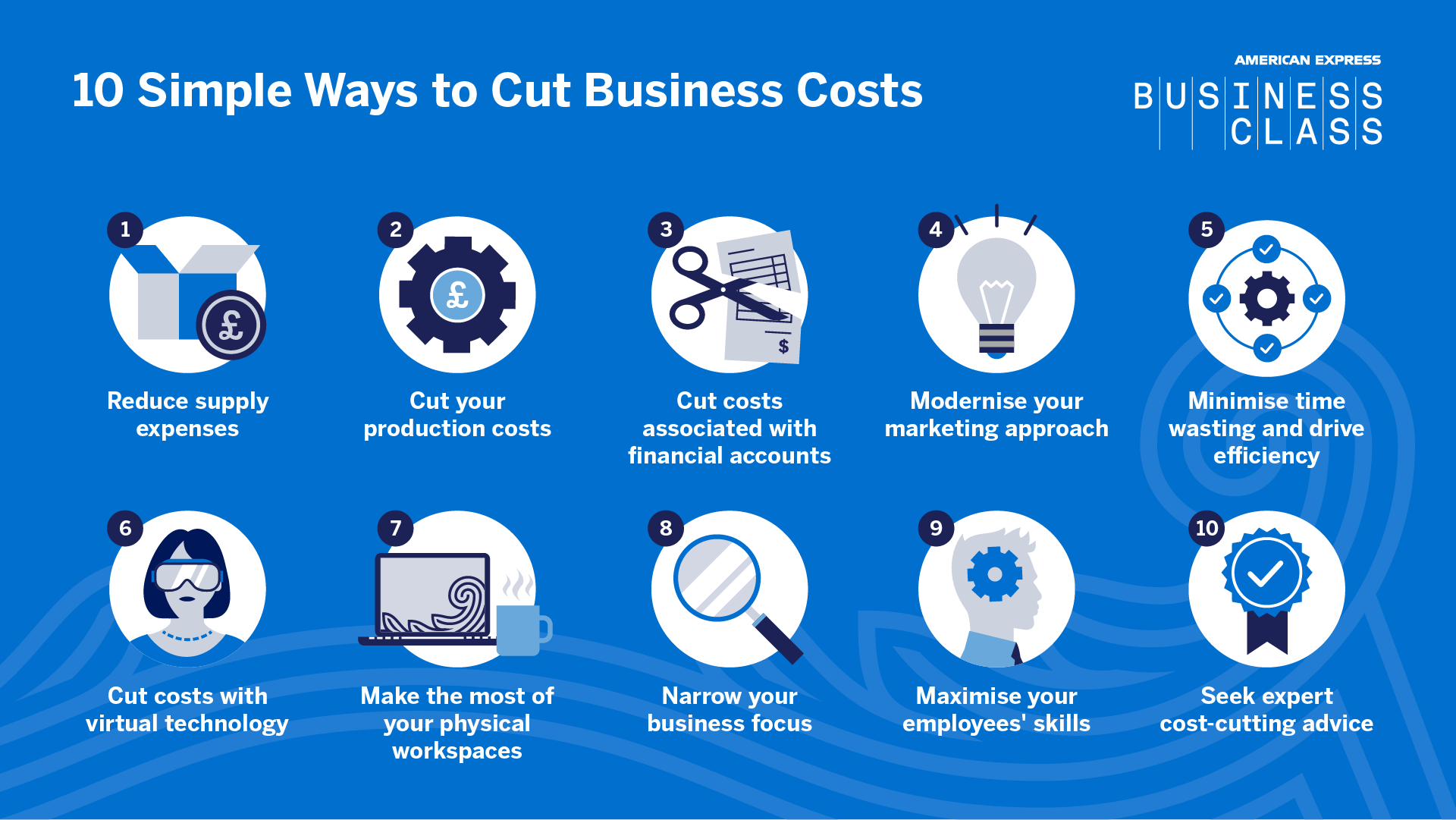How to Cut Costs in Business
Cutting costs in business can be tricky if you don't know where to start. It's worth taking some time to consider what you're doing well and where you can improve before you implement cost-cutting measures. Keep reading to find out 10 tips to help cut business costs.
 |
1. Reduce supply expenses
A business can optimise its supply expenses by negotiating bulk discounts with suppliers, implementing just-in-time inventory management, exploring alternative suppliers for cost-effective options, and leveraging technology for real-time monitoring and forecasting to minimise excess inventory and associated costs.
2. Cut production costs
As a business owner, it's common to look for ways to cut costs and optimise your resources. To cut production costs, you could:
- Streamline your supply chain to minimise delays and excess inventory, and try to negotiate better terms with your suppliers.
- Invest in energy-efficient equipment and practices to reduce utility costs.
- Assess whether there are any areas of your business which could benefit from automation or digitisation.
- Track and measure the operational efficiency of your business to adjust and optimise the use of available resources. Set performance parameters that reflect your efficiency goals and offer incentives when those goals are met.
- Ensure regular training for employees to enhance their skills and productivity, foster a culture of continuous improvement and involve employees in cost-cutting initiatives.
3. Cut costs associated with financial accounts
At regular intervals, try to review your financial accounts for possible cost-cutting opportunities. This could include:
- Where possible, implement technology and automation to streamline financial workflows, reducing the need for manual intervention and associated labour costs.
- Efficiently manage your cash flows to minimise idle cash and associated opportunity costs.
- Implement rigorous expense tracking and control mechanisms to identify and eliminate unnecessary or excessive spending in finance.
- Invest in training programs to enhance the financial literacy of your employees, potentially reducing the need for external financial services.
4. Improve digital marketing and social efforts
Many business owners are well aware of the power of organic social and digital media as a platform to reach new audiences. Below are some tips to help you improve your approach to digital marketing and social:
- Invest in digital marketing activity to reach new audiences. This could include SEO, content marketing, email newsletters, social media, and video and podcasts.
- Insert your brand and story into your online marketing efforts. This helps build brand affinity and equity which can be important intangible assets for a business.
- Recommendations, referrals and reviews can all be incredibly powerful to a business. Encourage feedback online and incentivise your current customers to recommend your brand. For example, 'recommend us to a friend' newsletters that include a reward from your business for successful referrals.
- Consider reaching new audiences and opportunities by creating valuable content related to your business on platforms like Instagram, Facebook, X and YouTube.
Make your marketing budget go further with the American Express® Business Gold Card, which is accepted by Google, Hootsuite, Buffer, and many other major marketing tools. Payment terms of up to 54 days give you time to properly assess the performance of your marketing campaigns – and figure out which ones work best for your business – before you commit to further spending¹. And for every £1 you spend, you’ll earn 1 Membership Rewards® point, which can be spent on essential business purchases with hundreds of retailers².
5. Maximise productivity and drive efficiency
Evidence shows that a happier workforce is a more productive one [1], and, in recent years, companies around the world have woken up to the benefits of this concept [2]. Here are some ways you can set the right tone for your company culture to maximise productivity and reduce overall costs in the long run:
- Where possible, listen to your employees and ask for feedback. Forging trust and transparency can be key to fostering a positive workplace culture.
- Try to be flexible in how you let your employees approach and manage their time. One report recently suggested that 56% of employees would be willing to accept a lower-paid job if it meant a better work-life balance, highlighting just how important flexibility can be for job-seekers [3].
- You can also use the labour productivity formula to help you better understand any potential productivity shortfalls in your business.
6. Cut costs with virtual technology
Add virtual technology to your cost reduction strategy. The effects of the COVID-19 pandemic have shown just how effective businesses can be by operating remotely. Virtual meetings help minimise travel expenses, and virtual offices can eliminate the need for physical space.
Software such as Google Drive and Microsoft Sharepoint can help you to collaborate on documents as an alternative to paper documents and meetings. By cost-cutting with virtual document sharing, you can save on office supplies such as ink, printer paper, and even postage. Not only does this save on costs, but it also reduces your business' carbon footprint.
7. Make the most of your physical workspaces
For those businesses that do have physical premises, analyse your current use of space. Overflowing storage, too many supplies, piles of paper files and awkward furniture and equipment placement are common space wasters, nor do they serve your bottom line.
Consolidate or centralise the different functions or departments of your business by using spaces for dual purposes. Simply, can different rooms feasibly serve different business purposes at different times? The opportunities will vary depending on the nature of your business.
8. Narrow your focus
As a business owner, narrowing your business focus can be one of the most effective strategies for cutting costs. By limiting the types of services you offer and projects you accept, you can often be more productive and produce higher-quality work.
Alternatively, narrowing your business focus is to subcontract. Rather than turn away business, maximise your capacity by outsourcing parts of your work whenever possible. More projects equal more revenue, while subcontracting can equal lower expenses.
9. Maximise your employees' skills
Optimise your workforce by assessing skills, aligning roles with strengths, and fostering efficiency. Encourage task exchange among employees for enhanced productivity, emphasising upskilling and training. A structured progression plan ensures continual development, boosting morale and fortifying your business for long-term success.
10. Seek expert cost-cutting advice
If you find it challenging to cut costs on your own, you may want to hire an expert to work with you on a cost-reduction strategy. A chartered accountant can give your business a clean sweep and show you how to cut business costs.
Learning how to cut costs in business is essential to saving you both time and money. Implementing tactics like reducing your supply expenses, using virtual technology, and combing through your financial accounts can make a significant difference in effectively cutting costs in your business, allowing you to free up finances to invest in growth3.
1. The maximum payment period on purchases is 54 calendar days and is obtained only if you spend on the first day of the new statement period and repay the balance in full on the due date. If you'd prefer a Card with no annual fee, rewards or other features, an alternative option is available – the Business Basic Card.
2. Membership Rewards points are earned on every full and eligible £1 spent and charged, per transaction. Terms and conditions apply.
3. The information provided in this article is for informational purposes only and does not constitute financial advice. Always consult a qualified professional before making financial decisions. We are not liable for any actions taken based on this information.
Sources
[1] Harvard Business Review, Creating a Happier Workplace is Possible - and Worth It, Oct 2023
[2] Science, 2023’s Top Employers: Making a happy workplace for employees, Oct, 2023
[3] People Management, Is work-life balance becoming more important than pay? 2023



